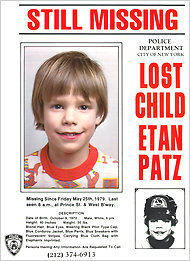|
PARIS — Their smiles never dim in missing posters and
their names loom large in their home countries: Tatiana,
Leo, Estelle and Madeleine.
When the police made an arrest Thursday in the 1979 disappearance
of 6-year-old Etan Patz in New York, the tragedy
underscored the unfinished searches for other children
whose parents continue to hunt for them with photographs
artfully retouched to transform baby faces into teens.
It was the case of Etan Patz that prompted the creation of the
National Missing Children’s Day in 1983 on the
anniversary of his disappearance on May 25. Three years
later an international day was created on the same date
to build awareness about missing children in other
countries.
Etan Patz, who vanished while walking to his school bus alone in
his SoHo neighborhood for the first time, was one of the
first missing children ever to appear on a milk carton
and became a turning point for parents who altered the
way they raised their children and protected them from
peril.
After decades of dashed hopes and conflicting clues, Pedro
Hernandez, 51, a former bodega store stock clerk, was
arrested Thursday on murder charges with a confession
that he lured the boy into a shop with the promise of a
soda, choked him in the basement and placed his body in
a bag and dumped it about a block away in the open
trash.
The police authorities said there was no physical evidence, but he
had given a detailed, signed confession along with
incriminating comments to others, including someone who
tipped off a Missing Persons Squad that Mr. Hernandez
spoke of killing a child in New York. He was held
overnight Thursday under suicide watch and transferred
to Bellevue Hospital Center on Friday morning. Whether
that confession is indeed true remains to be determined.
The Etan Patz case had impact abroad because it slowly built
awareness about the issue as it was changing enforcement
strategies in the United States. A wait and see attitude
about missing children eventually evolved into an
aggressive Amber Alert system that enlisted the public
into searches through television announcements and
postings on electronic highway billboards.
Those strategies came later in Europe, prompted by several high
profile cases, particularly the disappearance of
Madeleine McCann. At age 3, she vanished in Portugal in
2007 while her British family was on a resort vacation.
“Every high-profile case, unfortunately, helps raise awareness of
missing children and what people usually do not know is
that those cases represent just a small percentage of
the overall cases,” said Valeria Setti, a project
officer with Missing Children Europe, a Brussels
organization with member groups in 20 countries in
Europe. More than 60 percent of missing children in
Europe are runaways, most frequently teen girls, and 25
percent of disappearances involved parental abductions,
she added.
The Madeleine McCann case inspired closer cross-border
coordination, amid criticism of the slow response of the
Portuguese police investigation. It also helped give
rise to a new, confidential hotline, 116000, this month
to report sightings of missing children and offer
support and psychological counseling to parents in a
crisis.
The free service is available 24 hours a day in 16 European
countries, including Portugal, France, Spain and
Germany. “I think that Europe woke up then and the
institutions understood that they had to take some
steps,” Ms. Setti said.
The McCann family, whose ceaseless energy has kept the case in the
international spotlight, has also publicly supported the
new help number, calling it a “lifeline” for parents and
part of a shift in attitudes among politicians to
provide more resources.
They are also among the families who have turned to specialists to
transform the missing posters of their children into
teens, releasing a photo this month of Madeleine where
she is aged to look 9 years old.
Éric Mouzin, the father of Estelle who disappeared at age 9 in
France in 2003, has also issued an age-enhanced photo of
his daughter who was last seen walking home on a snowy
January day. It was her case that helped give rise to
France’s abduction alert system in 2006. Since it was
introduced, it has been used 10 times and all of the
children were found — eight as a direct result of the
alerts, according to Missing Children Europe.
In his 2011 memoir, “Find Estelle,” Mr. Mouzin reflected anger
about the “infinite slowness” of the investigation. This
year his support group, Association Estelle, is not
organizing any public demonstration in connection with
International Missing Children’s Day. “We don’t have the
energy,” he told Le Monde.
A version of this article appeared in
print on May 26, 2012, in The International Herald
Tribune |


